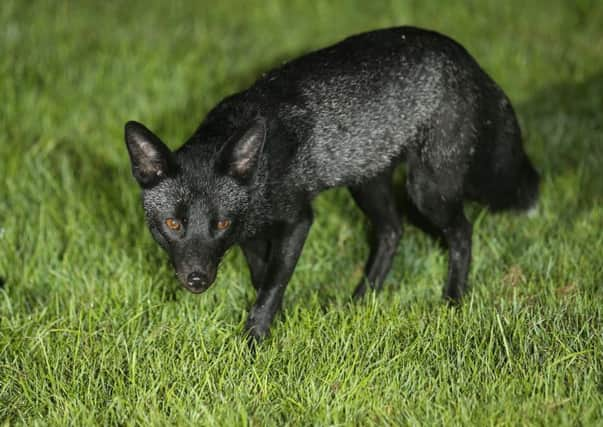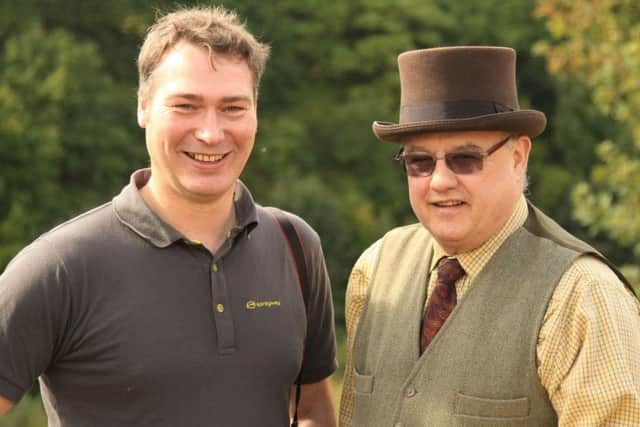Unexpected phone call leads Yorkshire artist to rare fox footage


There are only thought to be a handful of such creatures in the country. Although black in colour, they are technically known as ‘silver foxes’ since the fur is tipped with white. The coloration is all down to genetics.
Historically, silver foxes were among the most valued for their fur. Their silver-black skins were worn by nobles in Russia, Western Europe, and China and their pelts were considered to be of a higher quality even than that of a pine marten, beaver or otter.
Advertisement
Hide AdAdvertisement
Hide AdBut whilst they are virtually unheard of in Britain, I’ve read that silver foxes make up to eight per cent of Canada’s red fox population.


I gasped as my customer told me he’d seen the male black-coloured fox early in the morning on the opposite side of a steep valley from his flat. He was so enthusiastic about his sighting it was hard not to get caught up by his stories of ‘Black Fox’, as he named it.
Soon afterwards, this customer came to my gallery in Thixendale to show me his video footage. He arrived wearing a smart green tweed suit, tie and top hat. His real name was Robert Burns, but he introduced himself as ‘Black Fox Bob’, which made me chuckle. I couldn’t wait to see his footage so we went through to the house and plugged his camera into my widescreen TV.
As the video played, I couldn’t believe what I was seeing. I was expecting the fox to be dark, but this fox was as black as a labrador, with just the hint of silver highlights along its body. It had a beautiful white tip to its tail, just like a red fox.
Advertisement
Hide AdAdvertisement
Hide AdI watched entranced. It was amazing how relaxed the silver fox seemed to be as there was a busy dual carriageway just 20 yards up the bank as the country foxes I’m used to seeing are very wary.
The footage was a little shaky but nevertheless ‘Black Fox Bob’ had caught some fantastic sequences of two foxes, a black one and a common red one.
One of my favourite of his clips was of Black Fox flirting with a young red vixen. The vixen was sitting beneath him on the bank. He slid on his belly down the incline to join her. As he slipped alongside her, he stopped and stood up, then walked round her to regain the high ground.
He tried to be tender, sniffing around her face, but she rebuffed him with such a sharp snap that he slid down the bank. He tried again but this time he wasn’t so charming, grabbing at her tail with his teeth as he slid past. A few minutes later he sidled over to her and licked her round the muzzle. She sat upright and they both looked down the valley together. Then she curled up into a ball and started grooming herself.
Advertisement
Hide AdAdvertisement
Hide Ad‘Black Fox’ rushed towards her, excited by his success, then jumped over her and bounded away into some trees. He ran back and pounced on her but his front legs landed heavily on to her body. She looked less than impressed by these boyish antics and skulked off to sleep in some undergrowth.
I asked Black Fox Bob to keep me updated with his sightings and I started receiving highly-detailed letters and late night phone calls with the latest news.
By the end of June, he informed me that a larger male fox had come on the scene. Bob called this one ‘Daddy Fox’ and it sounded as though this large male was intent on taking over Black Fox’s patch.
To make the situation worse, the young vixen I’d seen footage of Black Fox flirting with had disappeared and an old vixen had come onto the scene. Black Fox appeared to be confused and lost without his mate.
Advertisement
Hide AdAdvertisement
Hide AdThen Black Fox Bob reported that Black Fox had got mange on his tail but by August his condition was better and he now had another vixen mate, which Bob called ‘New Red’.
Bob was keen for my advice on how to get better shots. I advised him to get closer to the foxes by using food as bait so he began leaving a trail of food that led closer and closer to his flat window. Soon he was getting better footage and he sent me clips of the two foxes. It looked like they’d paired up and may well go onto mate in the winter.
After all the clips I’d seen, I had to see Black Fox for myself so I headed off to Black Fox Bob’s town flat in West Yorkshire.
When I arrived we unloaded boxes and bags full of lights, flashes, infrared cameras, dimmer switches, wires, tripods, clamps, SLR cameras and lenses from my car and Bob took me on a tour of the fox’s territory.
Advertisement
Hide AdAdvertisement
Hide AdAs dusk started to fall we were back in the flat and were ready. I’d linked an infrared camera to the TV in his living room so we wouldn’t miss a single movement outside.
By 11pm we’d seen nothing but five minutes later, Bob said: “He’s here.” We tiptoed into Bob’s bedroom to get a better view out of the window. I’d rigged his garden with security lights and I gradually turned them on with a dimmer switch.
The black fox didn’t seem overly upset by this new development, although was less sure of the flash when I took a photograph. Thankfully after a few shots he relaxed and settled down to eat the food that Black Fox Bob had put out for him.
I got one final shot before he trotted off on his rounds of his territory, melting into the darkness of the city.
Award-winning photograph
Advertisement
Hide AdAdvertisement
Hide AdA photograph taken by Robert Fuller showing a battle between two sparrowhawks, their talons locked in deadly combat, their wings outstretched in hostility, is the dramatic subject of one of the winning pictures of the 2015 British Wildlife Photography Awards.
Shot as background research for a painting, it won ‘highly commended’ in the animal behaviour category of the acclaimed competition.
It took Mr Fuller six months of watching a wild sparrowhawk in his garden before he snapped the winning shot.
If you know of very unusual wildlife living near you Mr Fuller would like to hear about it. He can be contacted at his gallery on 01759 368355 or by email: [email protected]